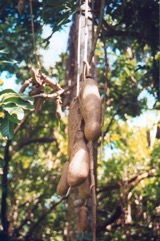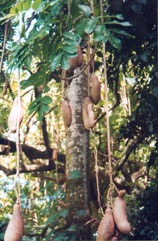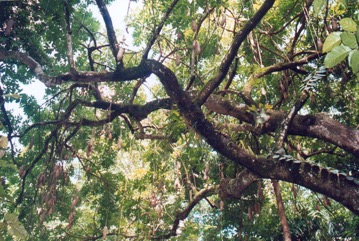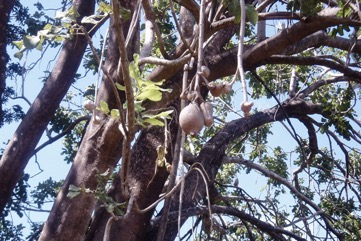Sausage tree

A tropical plant. It is native to tropical Africa. It grows in warm subtropical and tropical areas. It grows in wet savannah. It is also found naturally along rivers in moist rainforest. It grows in Miombo woodland. It suits humid locations. It occurs between 1,100 and 3,000 metres altitude in Uganda. In Kenya it grows from sea level to 2,200 m altitude and in areas with rainfall between 500-1.500 mm per year. It cannot stand heavy frosts. It can grow in arid places. In Cairns Botanical Gardens. It suits hardiness zones 10-12.
Also known as:
Barut, Bian, Bukurola, Cucumber tree, Edodoi, Fetish bean, Kiatine, Kunahagaali, Muatine, Mubveve, Musonya, Mussa, Muthigu, Muvevha, Muvhumati, Muweve, Mwegea, Myunguti, Ol-darboi, Ol-darpoi, Ol-sunguroi, Pohon kigeli, Pohon sosis, Tiembegh, Umvebe, Yago
Synonyms
- Bignonia africana Lam.
- Crescentia pinnata Jacq.
- Kigelia abyssinica A. Rich.
- Kigelia acutifolia Engl. ex Sprague
- Kigelia aethiopica Decne.
- Kigelia aethiopium (Fenzl) Dandy
- Kigelia angolensis Welw. ex Sprague
- Kigelia dinklagei Aubrev. & Pellegr.
- Kigelia elliotii Sprague
- Kigelia elliptica Sprague
- Kigelia erytraeae Mattei
- Kigelia ikbaliae Wildem.
- Kigelia impressa Sprague
- Kigelia lanceolata Sprague
- Kigelia madagascariensis Baker
- Kigelia moosa Sprague
- Kigelia perrottetti Aubrev. & Pellegr.
- Kigelia pinnata (Jacq.) DC.
- Kigelia somalensis Mattei
- Kigelia spragueana Wernham
- Kigelia talbotii Hutchinson & Dalziel
- Kigelia tristis A. Cheval
Edible Portion
- Seeds, Fruit, Bark, Flowers, Caution
Where does Sausage tree grow?
Found in: Africa, Andamans, Angola, Asia, Australia, Benin, Botswana, Burkina Faso, Burundi, Cameroon, Cape Verde, Central Africa, Central African Republic, CAR, Chad, China, Congo, Congo DR, Côte d'Ivoire, Dominican Republic, East Africa, Egypt, Equatorial-Guinea, Eritrea, Eswatini, Ethiopia, Gabon, Gambia, Ghana, Guinea, Guinée, Guinea-Bissau, Hawaii, India, Indochina, Indonesia, Iraq, Ivory Coast, Kenya, Laos, Liberia, Madagascar, Malawi, Maldives, Mali, Marquesas, Mozambique, Myanmar, Namibia, Niger, Nigeria, North Africa, Pacific, Pakistan, Rwanda, SE Asia, Senegal, Sierra Leone, Singapore, Somalia, South Africa, Southern Africa, South Sudan, Sudan, Swaziland, Tanzania, Togo, Uganda, United States, West Africa, West Indies, Zambia, Zimbabwe
Notes: There is only one Kigelia species. The fruit is used for medicinal purposes. It has anticancer properties. In Slovenia it is probably in a hot house.
Status: A famine food.
Growing Sausage tree
Cultivation: Plants are grown from seed. Seeds germinate poorly and slowly. Plants grow naturally from seeds. Seeds should be sown fresh. It can be grown from large cuttings.
Edible Uses: CAUTION: Both the ripe and unripe fruit are poisonous. The fruit pulp and bark are used for making beer. The seeds are used as a famine food after baking. The fruit are used with sugar to make drinks. The flowers are used in a sauce. They are eaten as a vegetable. The leaves are used to make a palmnut soup eaten by lactating women.
Production: The tree is slow growing in cool places and faster in warm locations. In Central African Republic it flowers in June and September.
Nutrition Info
per 100g edible portion| Edible Part | Energy (kcal) | Protein (g) | Iron (mg) | Vitamin A (ug) | Vitamin c (mg) | Zinc (mg) | % Water |
|---|---|---|---|---|---|---|---|
| Fruit | 54 | 0.8 | - | - | - | - | 85.4 |
| Leaves | - | - | 161 | - | - | - |
Sausage tree Photos





References
Allen, D. J., 2007, Wildflowers and Common Trees of East Africa. Camerapix Publishers p 144
Alyegba, S. S. et al, 2013, Ethnobotanical Survey of Edible Wild Plants in Tiv Communities of Benue State, Nigeria. Journal of Natural Sciences Research. Vol.3, No.7
Ambasta, S.P. (Ed.), 2000, The Useful Plants of India. CSIR India. p 308 (As Kigelia pinnata)
Asfaw, Z. and Tadesse, M., 2001, Prospects for Sustainable Use and Development of Wild Food Plants in Ethiopia. Economic Botany, Vol. 55, No. 1, pp. 47-62
Barwick, M., 2004, Tropical and Subtropical Trees. A Worldwide Encyclopedic Guide. Thames and Hudson p 235
Bekele-Tesemma A., Birnie, A., & Tengnas, B., 1993, Useful Trees and Shrubs for Ethiopia. Regional Soil Conservation Unit. Technical Handbook No 5. p 288
Bodkin, F., 1991, Encyclopedia Botanica. Cornstalk publishing, p 604 (As Kigelia pinnata)
Bonou, A., et al, 2013, Valeur economique des Produits Forestiers Non Ligneux (PFNL) au Benin. Editions Universitaires Europeennes p 98
Bremness, L., 1994, Herbs. Collins Eyewitness Handbooks. Harper Collins. p 60
Brickell, C. (Ed.), 1999, The Royal Horticultural Society A-Z Encyclopedia of Garden Plants. Convent Garden Books. p 581 (As Kigelia pinnata)
Bruschi, P., et al, 2014, Traditional use of plants in a rural community of Mozambique and possible links with Miombo degradation and harvesting sustainability. Journal of Ethnobiology and Ethnomedicine. 2014, 10:59
Burkill, H. M., 1985, The useful plants of west tropical Africa, Vol. 1. Kew.
Burkill, I.H., 1966, A Dictionary of the Economic Products of the Malay Peninsula. Ministry of Agriculture and Cooperatives, Kuala Lumpur, Malaysia. Vol 2 (I-Z) p 1296 (As Kigelia pinnata)
Cundall, P., (ed.), 2004, Gardening Australia: flora: the gardener's bible. ABC Books. p 779
Dale, I. R. and Greenway, P. J., 1961, Kenya Trees and Shrubs. Nairobi. p 60 (As Kigelia aethiopum)
Etherington, K., & Imwold, D., (Eds), 2001, Botanica's Trees & Shrubs. The illustrated A-Z of over 8500 trees and shrubs. Random House, Australia. p 415
Facciola, S., 1998, Cornucopia 2: a Source Book of Edible Plants. Kampong Publications, p 49
Food Composition Tables for use in Africa FAO http://www.fao.org/infoods/directory No. 1027 (As Kigelia pinnata)
Fowler, D. G., 2007, Zambian Plants: Their Vernacular Names and Uses. Kew. p 14
Fox, F. W. & Young, M. E. N., 1982, Food from the Veld. Delta Books. p 131
Glew, R. S., et al, 2010, An indigenous plant food used by lactating mothers in West Africa: the nutrient composition of the leaves of Kigelia africana in Ghana. Ecology of Food and Nutrition 49(1) :72-83
Goode, P., 1989, Edible Plants of Uganda. FAO p 30
Grivetti, L. E., 1980, Agricultural development: present and potential role of edible wild plants. Part 2: Sub-Saharan Africa, Report to the Department of State Agency for International Development. p 46 (As Kigelia aethiopum)
Gueye, M., et al, 2014, Wild Fruits Traditionally Gathered by the Malinke Ethnic Group in the Edge of Niokolo Koba Park (Senegal). American Journal of Plant Sciences 5, 1306-1317
Hall, N. et al, 1972, The Use of Trees and Shrubs in the Dry Country of Australia, AGPS, Canberra. p 197, 207, (As Kigelia pinnata)
Hearne, D.A., & Rance, S.J., 1975, Trees for Darwin and Northern Australia. AGPS, Canberra p 80, Pl 22 (As Kigelia pinnata)
Hedrick, U.P., 1919, (Ed.), Sturtevant's edible plants of the world. p 365 (As Kigelia pinnata)
Hibbert, M., 2002, The Aussie Plant Finder 2002, Florilegium. p 176 (As Kigelia pinnata)
http://www.ntbg.org/plants/plant details.php
http://www.botanic-gardens-ljubljana.com/en/plants
J. D. Hooker & G. Bentham in W. J. Hooker, Niger Fl. 463. 1849
Joffe, P., 2007, Creative Gardening with Indigenous Plants. A South African Guide. Briza. p 127
Johns, T., and Kokwaro, J.O., 1991, Food Plants of the Luo of Siayo District, Kenya. Economic Botany 45(1), pp 103-113
Katende, A.B., Birnie, A & Tengnas B., 1995, Useful Trees and Shrubs for Uganda. Identification, Propagation and Management for Agricultural and Pastoral Communities. Technical handbook No 10. Regional Soil Conservation Unit, Nairobi, Kenya. p 378
Kintzios, S. E., 2006, Terrestrial Plant-Derived Anticancer Agents and Plant Species Used in Anticancer research. Critical Reviews in Plant Sciences. 25: pp 79-113 (As Kigelia pinnata)
Krishen P., 2006, Trees of Delhi, A Field Guide. DK Books. p 248
Le Houerou, H. N., (Ed.), 1980, Browse in Africa. The current state of knowledge. International Livestock Centre for Africa, Ethiopia. p 161
Llamas, K.A., 2003, Tropical Flowering Plants. Timber Press. p 139
Long, C., 2005, Swaziland's Flora - siSwati names and Uses http://www.sntc.org.sz/flora/
Lord, E.E., & Willis, J.H., 1999, Shrubs and Trees for Australian gardens. Lothian. p 57
Lovett, J. C. et al, Field Guide to the Moist Forest Trees of Tanzania. p 26
Magwede, K., van Wyk, B.-E., & van Wyk, A. E., 2019, An inventory of Vhavenḓa useful plants. South African Journal of Botany 122 (2019) 57–89
Malaisse, F., 1997, Se nourrir en floret claire africaine. Approche ecologique et nutritionnelle. CTA., p 91.
Mannheimer, C. A. & Curtis. B.A. (eds), 2009, Le Roux and Muller's Field Guide to the Trees and Shrubs of Namibia. Windhoek: Macmillan Education Namibia. p 450
Maundu, P. et al, 1999, Traditional Food Plants of Kenya. National Museum of Kenya. 288p (As Kigelia pinnata)
Menninger, E.A., 1977, Edible Nuts of the World. Horticultural Books. Florida p 78 (As Kigelia pinnata)
Molla, A., Ethiopian Plant Names. http://www.ethiopic.com/aplants.htm
Morley, B. & Everard, B., 1970, Wild Flowers of the World. Ebury press. Plate 62
Mutie, F. G., 2020, Conservation of Wild Food Plants and Their Potential for Combatting Food Insecurity in Kenya as Exemplified by the Drylands of Kitui County. Plants 2020, 9, 1017
Njana, M. A., et al, 2013, Are miombo woodlands vital to livelihoods of rural households? Evidence from Urumwa and surrounding communities, Tabora, Tanzania. Forests, Trees and Livelihoods, 22:2, 124-140
Palgrave, K.C., 1996, Trees of Southern Africa. Struik Publishers. p 833
Palmer, E and Pitman, N., 1972, Trees of Southern Africa. Vol. 3. A.A. Balkema, Cape Town p 2011
Peters, C. R., O'Brien, E. M., and Drummond, R.B., 1992, Edible Wild plants of Sub-saharan Africa. Kew. p 69
Roodt, V., 1998, Trees & Shrubs of the Okavango Delta. Medicinal Uses and Nutritional value. The Shell Field Guide Series: Part 1. Shell Botswana. p 137
Royal Botanic Gardens, Kew (1999). Survey of Economic Plants for Arid and Semi-Arid Lands (SEPASAL) database. Published on the Internet; http://www.rbgkew.org.uk/ceb/sepasal/internet [Accessed 4th April 2011]
Ruffo, C. K., Birnie, A. & Tengnas, B., 2002, Edible Wild Plants of Tanzania. RELMA p 406
Ruiters-Welcome, A. K., 2019, Food plants of southern Africa. Ph.D. thesis. Univ. of Johannesburg p 38
Schmidt, E., Lotter, M., & McCleland, W., 2007, Trees and shrubs of Mpumalanga and Kruger National Park. Jacana Media p 600
Schuler, S., (Ed.), 1977, Simon & Schuster's Guide to Trees. Simon & Schuster. No. 132 (As Kigelia pinnata)
Shumsky, S., et al, 2014, Institutional factors affecting wild edible plant (WEP) harvest and consumption in semi-arid Kenya. Land Use Policy 38(2014) 48-69
Sujanapal, P., & Sankaran, K. V., 2016, Common Plants of Maldives. FAO & Kerala FRI, p 161
Sukarya, D. G., (Ed.) 2013, 3,500 Plant Species of the Botanic Gardens of Indonesia. LIPI p 345
Swaminathan, M.S., and Kochnar, S.L., 2007, An Atlas of Major Flowering Trees in India. Macmillan. p 214 (As Kigelia pinnata)
Swaziland's Flora Database http://www.sntc.org.sz/flora
Tewari, D.N., 1994, Important Plants of India. International Book Distributors, India. p 29
Venter, F & J., 2009, Making the most of Indigenous Trees. Briza. p 198
von Katja Rembold, 2011, Conservation status of the vascular plants in East African rain forests. Dissertation Universitat Koblenz-Landau p 170
White, F., Dowsett-Lemaire, F. and Chapman, J. D., 2001, Evergreen Forest Flora of Malawi. Kew. p 169
Williamson, J., 2005, Useful Plants of Malawi. 3rd. Edition. Mdadzi Book Trust. p 144
van Wyk, B, van Wyk, P, and van Wyk B., 2000, Photographic guide to Trees of Southern Africa. Briza. p 185
Wickens, G.E., 1995, Edible Nuts. FAO Non-wood forest products. FAO, Rome. p 109
World Checklist of Useful Plant Species 2020. Royal Botanic Gardens, Kew
www.worldagroforestrycentre.org/treedb/
www.zimbabweflora.co.zw 2011